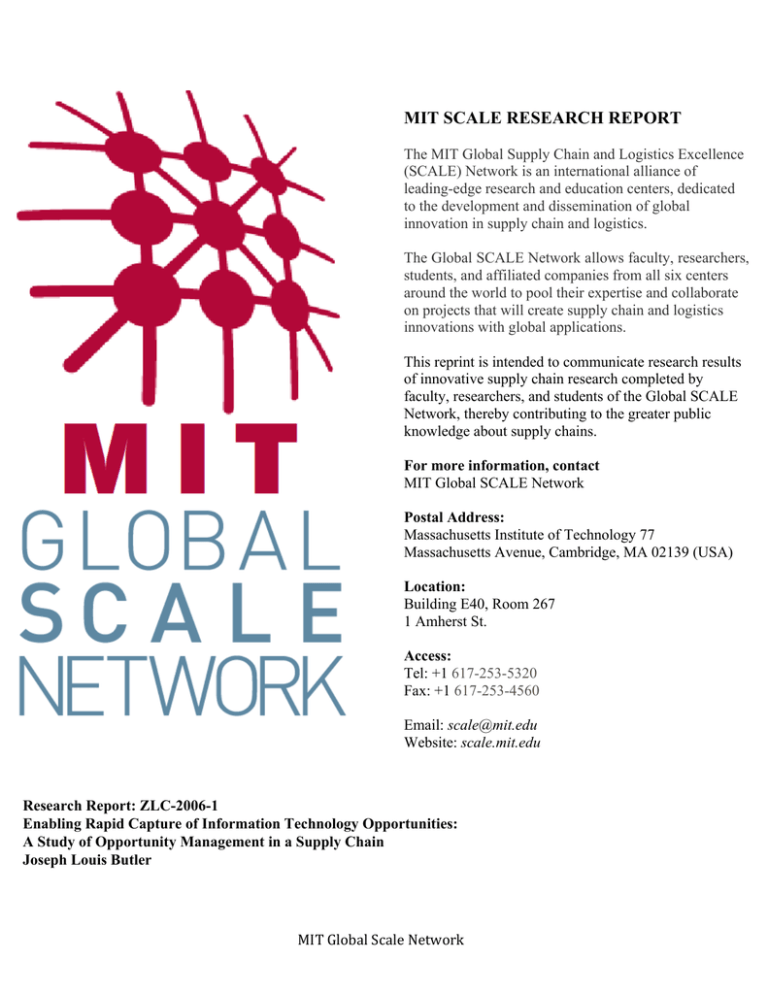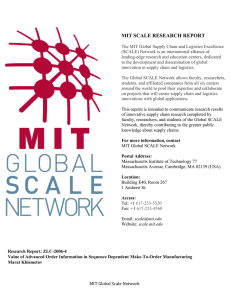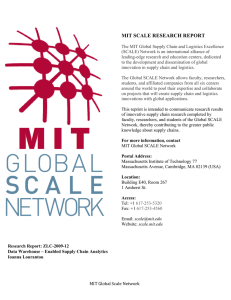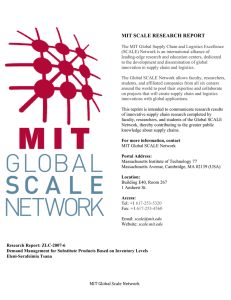MIT SCALE RESEARCH REPORT
advertisement

MIT SCALE RESEARCH REPORT The MIT Global Supply Chain and Logistics Excellence (SCALE) Network is an international alliance of leading-edge research and education centers, dedicated to the development and dissemination of global innovation in supply chain and logistics. The Global SCALE Network allows faculty, researchers, students, and affiliated companies from all six centers around the world to pool their expertise and collaborate on projects that will create supply chain and logistics innovations with global applications. This reprint is intended to communicate research results of innovative supply chain research completed by faculty, researchers, and students of the Global SCALE Network, thereby contributing to the greater public knowledge about supply chains. For more information, contact MIT Global SCALE Network Postal Address: Massachusetts Institute of Technology 77 Massachusetts Avenue, Cambridge, MA 02139 (USA) Location: Building E40, Room 267 1 Amherst St. Access: Tel: +1 617-253-5320 Fax: +1 617-253-4560 Email: scale@mit.edu Website: scale.mit.edu Research Report: ZLC-2006-1 Enabling Rapid Capture of Information Technology Opportunities: A Study of Opportunity Management in a Supply Chain Joseph Louis Butler MITGlobalScaleNetwork For Full Thesis Version Please Contact: Marta Romero ZLOG Director Zaragoza Logistics Center (ZLC) Edificio Náyade 5, C/Bari 55 – PLAZA 50197 Zaragoza, SPAIN Email: mromero@zlc.edu.es Telephone: +34 976 077 605 MITGlobalScaleNetwork ________________________________________________________ Enabling Rapid Capture of Information Technology Opportunities A Study of Opportunity Management in a Supply Chain Joseph Louis Butler EXECUTIVE SUMMARY ________________________________________________________ Advantageous IT opportunities can enable companies to cut costs, improve revenues, or gain efficiencies to create a competitive advantage. Companies have many IT opportunities to choose from, however, most are slow at implementing the best. They look for answers to quickly evaluate opportunities for acceptability and implement the same within their business and system environments. In few industries are competitive pressures felt as acutely as in consumer electronics. This thesis explores the pre-project processes and workflows of a global consumer electronics and telecommunications leader within the role of demand and supply planning. Similar to many, they are challenged at quickly evaluating and implementing opportunities. Despite the vast amount of literature that has been written about finding opportunities, as well as quickly managing projects, little has been written about the activities that should precede project management. In part, the challenge is due to tight budgets, but the core of the problem can be traced to the following: Process Structure: Corporations lack a definitive process to manage opportunities, and have not defined clear roles and responsibilities. Managing opportunities is an organizational problem that has to be addressed by multiple people with different functions. Although most companies understand how to model and manage processes, within the overall lifecycle of an opportunity, the lack of pre-project processes is a substantial bottleneck. Information Structure & Standards: Corporations have not defined what information is required, when it is most beneficial, and who it should come from, in order to proceed with an opportunity. Additionally, they lack definition of how information and business models should be used within the pre-project activities. A company must determine how much information is required to make an effective analysis and how much effort will be expended to gather requirements for each Executive Summary, MIT-Zaragoza Master’s Thesis, 2006 1 ERCITO opportunity. This is a balancing act between being precise and being quick which has cost and opportunity cost implications on both sides IT Tools: Information systems assist in aspects of project management, but fall short of facilitating opportunity management. Some companies have created their own inhouse tools; however, most of these lack integration with project management modules. Management Support: Management lacks awareness of how to be involved in performing opportunity management and fails to gives incentives and support to ensure that opportunities are appropriately captured in the organization. The degree to which companies are affected by these problems is different for each company. Some companies have created in-house IT tools to perform opportunity management. Some have established cross-functional groups to evaluate opportunities. For the most part, however, typical reaction from users and managers is that activities preceding projects are vague and follow a case-by-case evaluation. Companies will benefit from implementation of the following recommendations: Standardize Pre-Project Activities: Create a standard workflow and set of activities to follow for each opportunity. Define how process models will be used. Additionally, standardize the process for gathering requirements and analyzing opportunity costs and benefits. Because opportunity management is the responsibility of stakeholders with diverse functional backgrounds, creating a structured methodology and processes will facilitate comprehension. Include Opportunity Management in IT Strategy: Create or purchase an adequate system to facilitate capture and evaluation of all sources of opportunities. This will enable standardization of workflows and activities. Determine what information will be needed, and how it will be used during the pre-project stage. Provide Management Support: Management needs to provide its organizations with sufficient time and resources to proactively evaluate opportunities. Management needs to ensure that advantageous opportunities are not overlooked by utilizing incentives or otherwise. By implementing these recommendations, a company can improve their ability to rapidly select the most advantageous opportunities. Additionally, they will remit to project management a better prepared seriatim, with better defined, structured opportunities. This thesis proposes a framework of activities to standardize a pre-project stage. It demonstrates how deficiencies in a company’s ability to rapidly implement opportunities can be overcome by application of the framework. It proposes specifications for an IT system that can facilitate the activities of opportunity capture, definition, evaluation, ranking, and post-implementation value analysis. Executive Summary, MIT-Zaragoza Master’s Thesis, 2006 2










